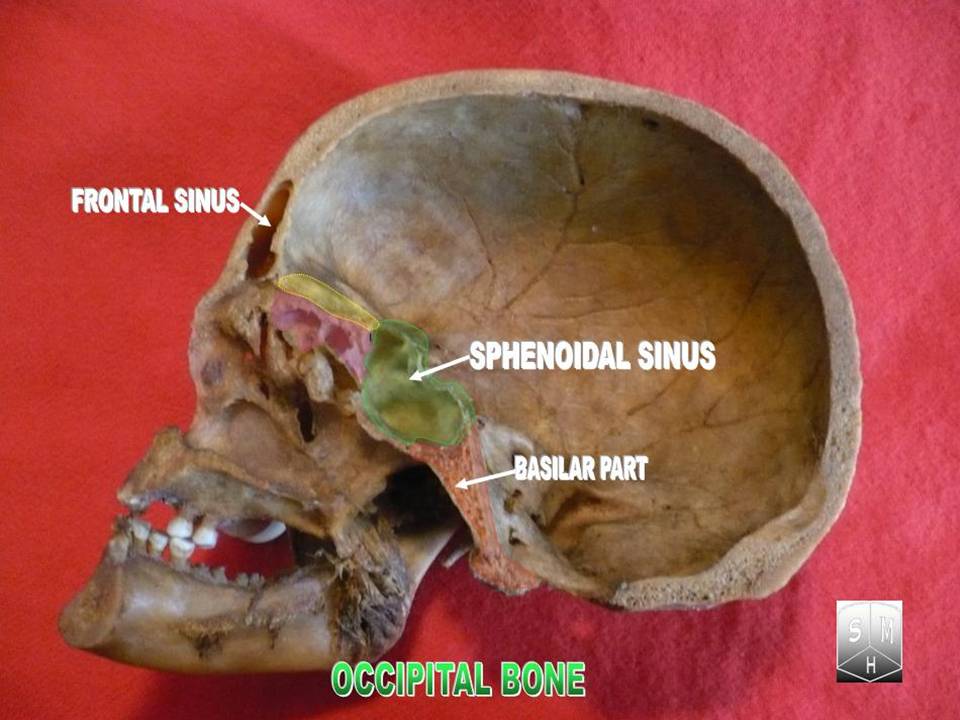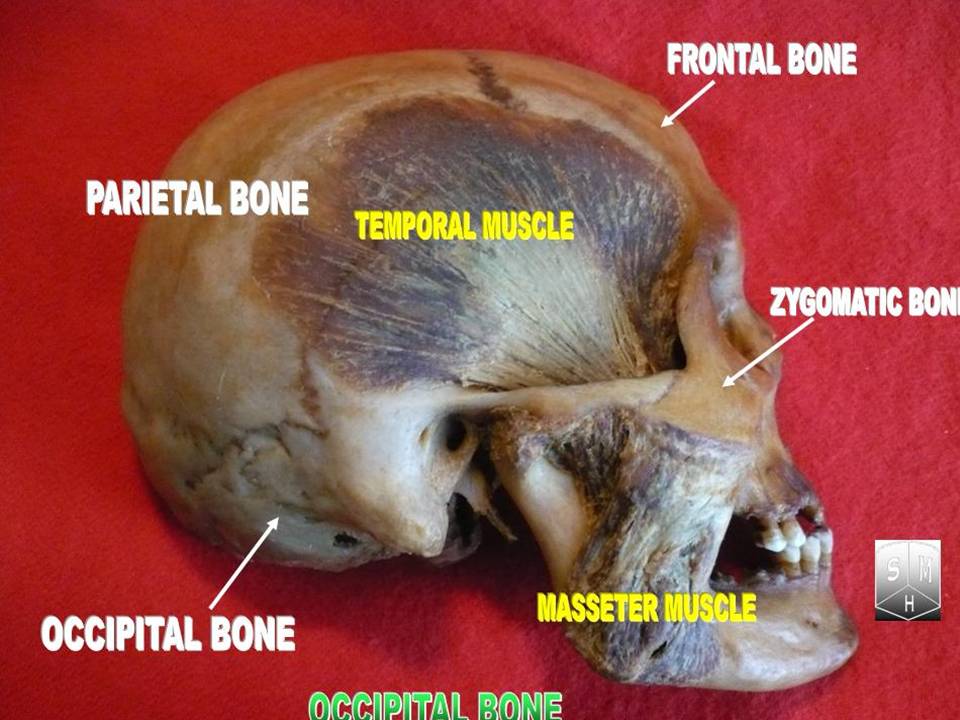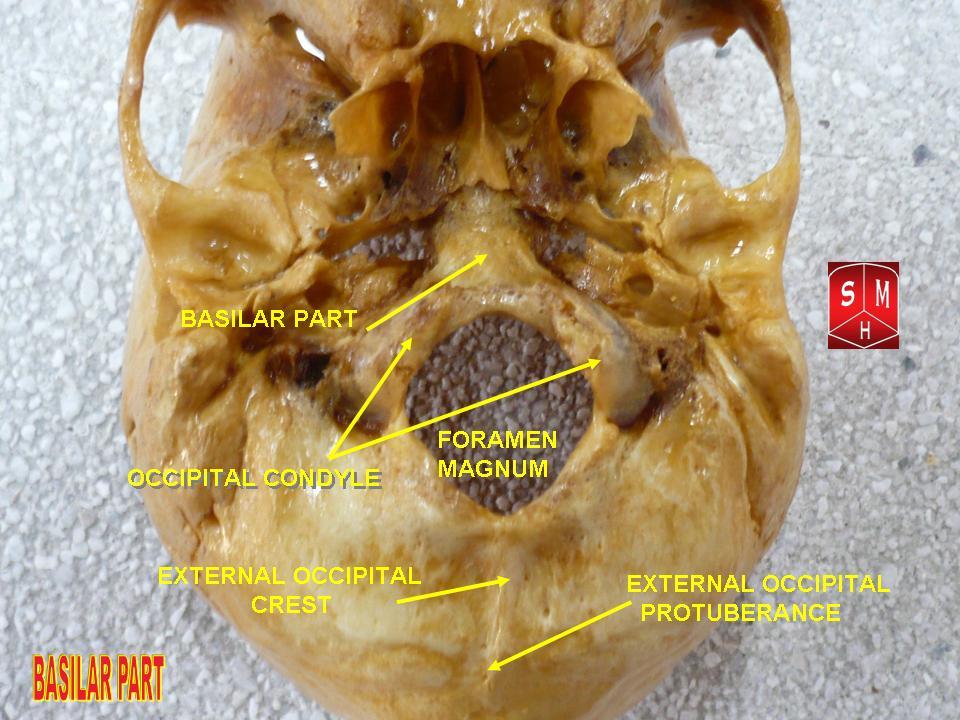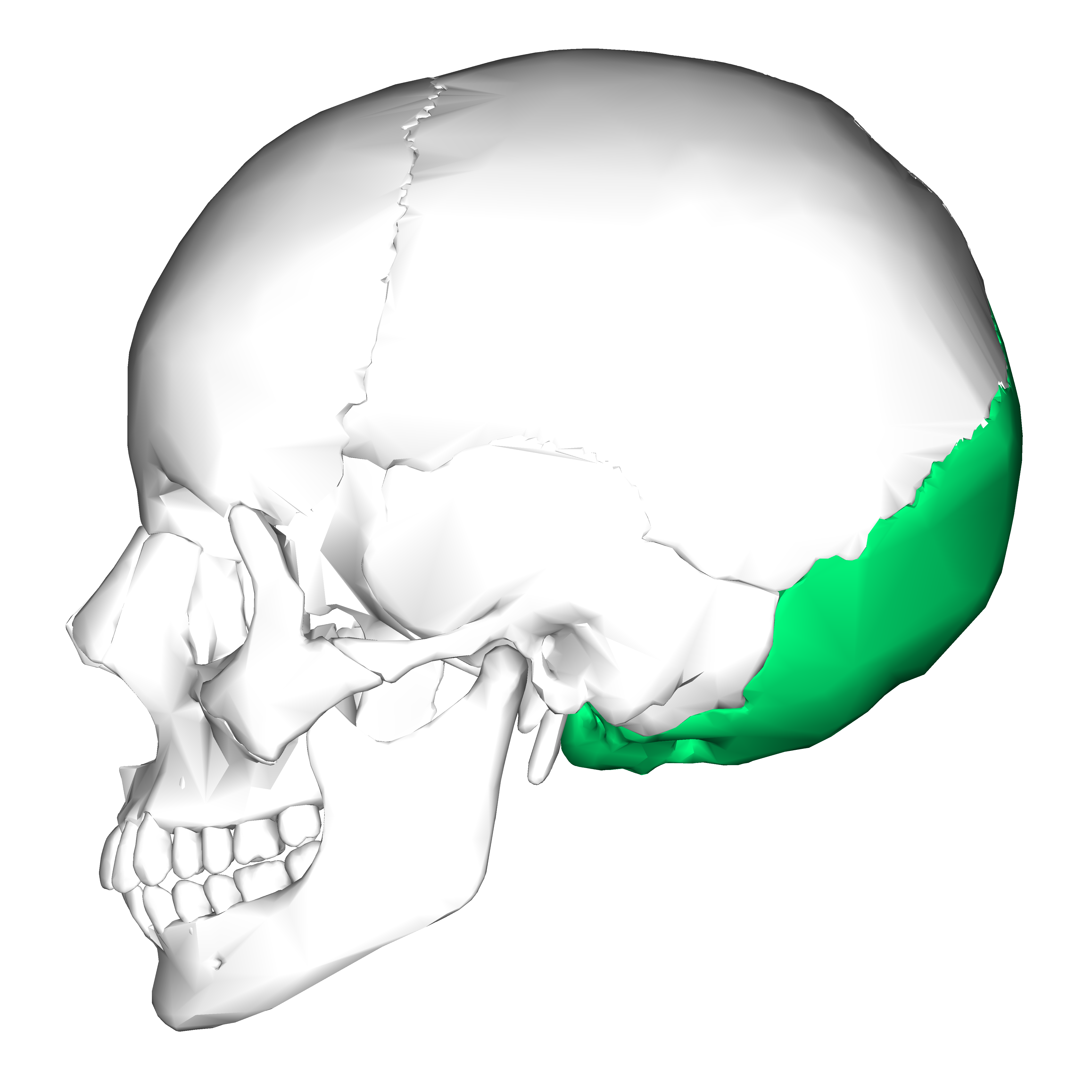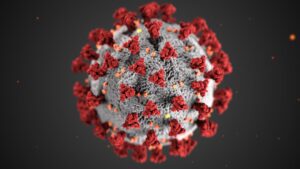Located at the back of the skull, the occipital bone serves an essential role in the human cranium’s structural integrity. Shaped like a trapezoid, it has a concave front surface, a convex back surface, and encloses a significant oval opening known as the foramen magnum. This gateway allows the cranial cavity to connect seamlessly with the vertebral canal.

Components of the Occipital Bone
The occipital bone is divided into three parts, each playing a unique role in our anatomy:
- Squamous Part: This expanded area lies above and behind the foramen magnum, featuring two surfaces (external and internal), three angles (one superior and two lateral), and four borders (two Lambdoid and two mastoids).
- Basilar Part: Situated in front of the foramen magnum, this quadrilateral and thick segment offers robust structural support.
- Condylar Parts: These lateral components, one on each side of the foramen magnum, bear the occipital condyles, connecting the basilar and squamous parts.
An Unveiling of The Human Occipital Bone: An Interactive Journey
Venture with me into the captivating world of the human occipital bone! This complex structure isn’t just a piece of our anatomy puzzle; it’s a cornerstone of our skull. Let’s take an interactive journey that will keep us on our toes. So, medical students, fasten your seatbelts, let’s dive head first!
- The Anatomical Position: Picture this! Our occipital bone is seated like a king on a throne, its occipital condyles pointing down like the sharp gaze of a ruler. The basilar part faces forward and upwards, setting the stage for the rest of the show.
- The Squamous Part: This part of our skull isn’t just another bone; it’s a master of disguise with an array of features.
- It has two surfaces – external and internal, like the covers of an intriguing novel.
- It has three angles, one superior and two lateral, like a triptych painting each telling a different story.
- It has four borders: 2 lambdoid and 2 mastoids, each on either side of the median plane – providing a perfect symmetry that would impress even the most discerning architect.
- The External Surface: As we step outside, the external surface is undulating, swelling and receding like the ocean’s tide. Upon closer inspection, you’ll see the external occipital protuberance, a noticeable landmark situated midway between the posterior margin of the foramen magnum and the superior angle of the bone. This prominence, also known as the inion, forms a pivot point, where the superior sagittal sinus ends and the transverse sinus begins. Moreover, it’s not just about structure; it’s about function too. This protuberance gives attachment to the highest point of the ligamentum nuchae, a beacon of sorts for this crucial ligament.
- The Story of Lines and Crests: The occipital bone is adorned with several lines and crests, each with a purpose, each with a tale to tell:
- Highest Nuchal Line: This is an elusive entity, sometimes present, sometimes not. If it decides to grace us with its presence, you’ll find it curving laterally from the external occipital protuberance. It anchors the galea aponeurotica (epicranial aponeurosis). The area above this line hosts the occipital belly of the occipito frontalis and the galea aponeurotica.
- Superior Nuchal Line: Just below our sometimes-there guest is the superior nuchal line. Not shy like its counterpart, it is well-marked and carries significance. The medial part is a proud birthplace to the highest fibres of the trapezius. The lateral part is a homestead for the occipital belly of the occipito-frontalis. Below this line, we find the insertions of the sternocleidomastoid and the Splenius capitis. In the middle, it forms an apex of the posterior triangle and meets the occipital artery.
- External Occipital Crest: This ridge is like a royal road in the median plane, leading from the external occipital protuberance to the foramen magnum. It serves as a secure foothold for the ligamentum nuchae.
- Inferior Nuchal Line: This line curves laterally on each side from the middle of the external occipital crest. Here, it provides a steady anchoring point for the Rectus capitis posterior minor.
Let’s Dance! Muscular Attachments and the Intricate Ballet of the Occipital Bone
To medical students with a passion for understanding the human body’s detailed design, allow me to take you on an engaging exploration of the muscular attachments of the occipital bone.
Picture the occipital bone as an extravagant ballroom floor, with every dancer, or in this case, muscle, knowing its unique place on this stage.
The Dance of Insertions:
- Semispinalis Capitis: This dancer makes its grand entrance in the medial part of the area between the superior and inferior nuchal lines. A vital player in extending and rotating the head.
- Obliquus Capitis Superior: This mover shakes to the lateral part of the area between the superior and inferior nuchal lines, helping to rotate the head.
- Rectus Capitis Posterior Minor: This solo artist grooves to the medial part of the inferior nuchal line and into the area between the line and foramen magnum, assisting in extending the head at the neck.
- Rectus Capitis Posterior Major: Its stage is the lateral part of the inferior nuchal line and the area just below this line, also involved in extending and rotating the head.
- Splenius Capitis: Occupies the rough area just below the lateral 1/3rd of the superior nuchal line, contributing to neck extension and rotation.
- Sternocleidomastoid: This dynamic dancer holds a solo performance on the lateral half of the superior nuchal line, participating in various head and neck movements.
The Rhythm of Origins:
- Trapezius: Starts its performance from the medial 1/3rd of the superior nuchal line and external occipital protuberance, involved in various shoulder and neck movements.
- Occipital Belly of Occipito-frontalis: Begins its rhythm from the lateral 2/3rd of the superior nuchal line, playing a part in scalp and eyebrow movements.
Turning inward, the internal or cerebral surface of the occipital bone reveals a deeply concave landscape presenting fascinating features including protuberances, sulci, crests and fossae. Each contributing to form the space for our brain and its protective coverings.
Angles and Borders:
Angles and borders of the occipital bone further enhance its complexity. The superior angle is created by the meeting of two lambdoid borders and articulates with the occipital angles of the parietal bones. The lateral angles are formed where the lambdoid and mastoid borders meet, lying between the parietal bones and the mastoid part of the temporal bone.
As for the borders, the lambdoid borders, one on each side, extend from the superior angle to the lateral angle and articulate with the occipital border of the parietal bones of the same side to form the lambdoid suture. The mastoid borders, one on each side, extend from the lateral angle to the Jugular process, articulating with the mastoid part of the temporal bone.
A Closer Look at the Squamous Part
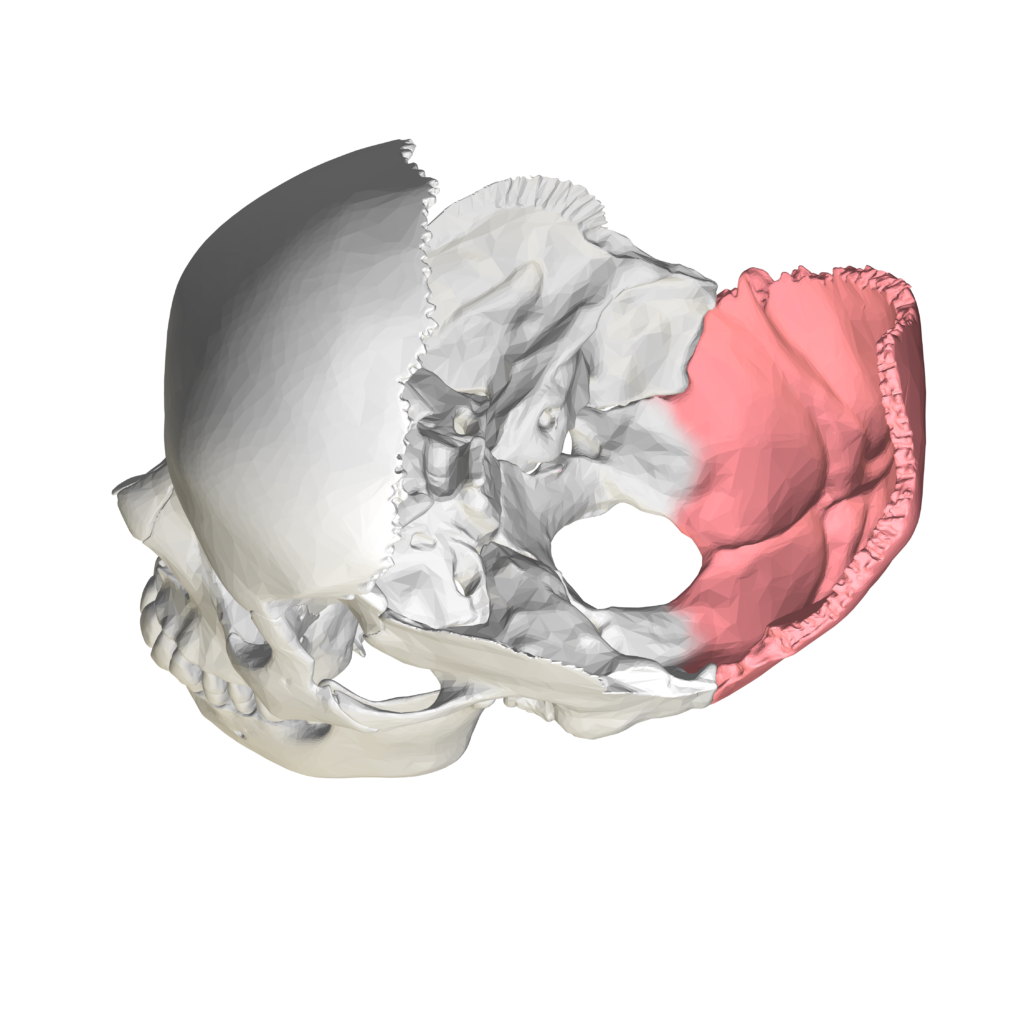
The squamous part presents an external and internal surface, each featuring unique landmarks and attachment points.
External Surface Features:
- External Occipital Protuberance: A significant bony landmark easily identifiable as the inion. The superior sagittal sinus terminates, and the transverse sinus begins opposite this level.
- Highest and Superior Nuchal Lines: Curved lines offering attachment points for various muscles and ligaments, such as the galea aponeurotica and the trapezius.
- External Occipital Crest: A ridge running in the median plane from the external occipital protuberance to the foramen magnum. It offers attachment to the ligamentum nuchae.
- Inferior Nuchal Line: Provides attachment to the Rectus capitis posterior minor.
Internal Surface Features:
- Internal Occipital Protuberance and Crest: These structures form part of the cerebellar and cerebral fossae.
- Sagittal and Transverse Sulci: These grooves lodge the superior sagittal and transverse sinuses, respectively.
Examining the Basilar Part

The basilar part is a thick, quadrilateral component that extends upward and forward from the foramen magnum, having two lateral borders that articulate with the petrous part of the temporal bone.
Unraveling the Condylar Parts

Each condylar part features
- Superior Surface
- Inferior Surface
- presents important features such as the occipital condyles and the hypoglossal canal.
The Hidden Wonders of the Inferior Surface: A Guided Tour
To all future medical savants, I invite you to embark on a fascinating journey of exploration as we delve into the detailed architecture of the occipital bone’s inferior surface. Picture this area as a landscape adorned with various captivating landmarks, each carrying its unique functionality and charm.
Occipital Condyles: Two oval or kidney-shaped structures make a star appearance, one on each side. Their convex articular surfaces, with their long axis directed forward and medially, create an elegant dance with the superior concave articular facet of the atlas, forming an atlantooccipital joint. Surrounding the condyle’s edges is the capsular Ligament of the atlantooccipital joint, attaching firmly to its margins. On the medial side of the condyle, a unique rough patch or tubercle serves as the anchoring point for the alar ligament.
Hypoglossal Canal: Positioned above the anterior part of each condyle and below the jugular tubercle, this canal has a trio of crucial elements passing through it:
- Hypoglossal nerve
- Meningeal branch of the ascending pharyngeal artery
- Emissary vein connecting the basilar venous plexus with the pterygoid venous plexus.
Condylar Fossa: Found behind each condyle, this depression hosts the posterior part of the superior facet of the atlas when the head leans back.
Condylar Canal: An occasional visitor, it graces the occipital bone when the condylar fossa is perforated. If present, it serves as a conduit for an emissary vein connecting the sigmoid sinus with veins of the suboccipital triangle.
Jugular Process: A quadrilateral piece of bone extending laterally from the posterior half of each occipital condyle, it boasts three surfaces:
- Upper Surface: Cradles the terminal part of the sigmoid sinus in its groove.
- Lower Surface: Serves as an insertion point for the Rectus capitis lateralis. Occasionally, it may sport a small eminence, the paramastoid process, which in certain skulls may be long enough to articulate with the transverse process of the atlas.
- Anterior Surface: Features the jugular notch, which transforms into the jugular foramen when articulated with the petrous part of the temporal bone.
The jugular foramen, divided into three compartments by two bony spicules (intrajugular processes), ushers through a variety of essential elements:
- Anterior Compartment: Carries the inferior petrosal sinus.
- Middle Compartment: Conveys the IX (Glossopharyngeal), X (vagus), and XI (Accessory) cranial nerves, a meningeal branch of the ascending pharyngeal artery, and occasionally an emissary vein.
- Posterior Compartment: Hosts the sigmoid sinus.
Clinical Significance of the Occipital Bone
Understanding the anatomy of the occipital bone is crucial as trauma to this region can cause basilar skull fractures. In the obstetric context, identifying the location of the fetal occiput is essential for successful delivery.
In conclusion, the occipital bone’s intricate anatomy demonstrates the human body’s remarkable design, with each component serving a specific, crucial function.
